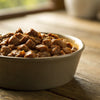Does Wet Dog Food Make Dogs Gain Weight? Understanding the Impacts of Diet on Canine Health
- Houndsy
Table of Contents
- Introduction
- Understanding Wet Dog Food
- The Impact of Wet Dog Food on Weight Gain
- Benefits of Wet Dog Food
- Potential Downsides of Wet Dog Food
- Mixing Wet and Dry Dog Food
- Case Studies
- Conclusion
- FAQs
Introduction
As pet parents, we want to ensure that our furry companions are healthy and happy. Did you know that around 56% of dogs in the United States are classified as overweight or obese? This staggering statistic highlights the importance of understanding how our choices in dog food can affect our pets' weight and overall health. One common question we often hear is: does wet dog food make dogs gain weight?
In this comprehensive blog post, we will explore the effects of wet dog food on canine weight gain, examining its nutritional properties, palatability, and digestibility. We’ll also discuss the benefits and potential downsides of incorporating wet food into your dog's diet, and how to strike the right balance for optimal health. By the end of this post, you’ll have a well-rounded understanding of how wet dog food fits into the broader picture of pet nutrition and weight management.
So, let’s dive into the fascinating world of dog food and how it impacts our four-legged friends' waistlines.
Understanding Wet Dog Food
What is Wet Dog Food?
Wet dog food, sometimes referred to as canned or moist food, is typically made with a mixture of meat, vegetables, and broth, providing a soft and palatable option for dogs. It is often more appealing to dogs due to its smell and texture compared to dry kibble. Wet food generally contains a higher moisture content, which can aid in hydration, especially for dogs that may not drink enough water daily.
Nutritional Composition
When considering whether wet dog food might lead to weight gain, it’s essential to examine its nutritional composition. Wet dog food typically contains:
- Higher moisture content: Usually around 70-80% water, which can help keep dogs hydrated.
- Protein: Many wet foods are rich in protein, vital for muscle maintenance and overall health.
- Fat content: Wet foods often have a varying fat percentage, which directly contributes to caloric density.
- Carbohydrates: Some wet foods contain grains or fillers, which can influence weight gain if not balanced correctly.
The caloric density of wet food varies significantly depending on the brand and ingredients used. For example, some wet foods may have higher fat content, making them more calorically dense, while others may focus on lean protein sources.
The Impact of Wet Dog Food on Weight Gain
Does Wet Dog Food Cause Weight Gain?
The short answer is: it can, but it doesn't inherently do so. The potential for weight gain from wet dog food largely depends on several factors, including:
- Caloric intake: If the total caloric intake exceeds a dog's daily energy expenditure, weight gain is likely, regardless of whether the food is wet or dry.
- Quality of ingredients: High-quality wet foods that prioritize protein and fiber will support overall health better than those filled with fillers and low-quality ingredients.
- Portion control: Just like humans, dogs can overeat. If portions are not managed correctly, even low-calorie wet food can lead to weight gain.
Palatability and Overeating
One of the significant advantages of wet dog food is its palatability. Dogs often prefer the taste and aroma of wet food, which can lead to increased food intake. If you notice that your dog is eager to eat wet food, it might be tempting to give them more than the recommended portion. This could inadvertently lead to weight gain.
Nutritional Balance
When transitioning from dry to wet food, it's essential to consider the overall balance of your dog's diet. Many dog owners find success by mixing wet and dry foods to create a balanced meal that provides the benefits of both types. The Houndsy Kibble Dispenser can help with this process by allowing for precise portion control, ensuring that your dog receives the right amount of food—no more guessing!
Benefits of Wet Dog Food
Increased Hydration
One of the most significant benefits of wet dog food is its high moisture content. Dehydration is a common issue in dogs, particularly in aging pets or those with less interest in water. Wet food can help increase overall hydration, promoting better kidney function and urinary health.
Easier to Chew
For puppies, senior dogs, or those with dental issues, wet food can be much easier to chew and digest. This can be especially beneficial for dogs recovering from surgery or those with sensitive stomachs.
Enhanced Nutritional Value
Many wet foods are formulated with high-quality ingredients, providing a well-rounded source of nutrition. Dogs that are picky eaters may be more inclined to consume a nutritionally balanced diet if it includes wet food.
Potential Downsides of Wet Dog Food
Cost Considerations
Wet dog food is generally more expensive than dry kibble. If budget constraints are a concern, it may be necessary to balance feeding wet food with high-quality dry food to maintain a healthy diet without overspending.
Spoilage and Storage
Wet food has a shorter shelf life once opened and can spoil quickly if left out for long periods. This can lead to waste and increased costs. Proper storage is essential to ensure the food remains fresh and safe for your dog.
Dental Health
While wet food can be softer and easier to chew, it may not provide the same dental benefits as dry kibble, which can help scrape plaque and tartar off teeth. Regular dental care, including teeth brushing and dental chews, is essential if your dog primarily eats wet food.
Mixing Wet and Dry Dog Food
A Balanced Approach
Many pet owners choose to mix wet and dry dog food to take advantage of the benefits of both. This approach can provide a balanced diet that accommodates your dog’s preferences while also ensuring they receive adequate nutrition.
When mixing, it’s important to maintain proper portion sizes to avoid overfeeding. The Houndsy Kibble Dispenser’s design allows for easy measurements, helping you stay on track with your dog’s dietary needs.
Transitioning Between Foods
If you're considering switching your dog to a wet food diet, make sure to transition gradually. A sudden change in diet can lead to gastrointestinal upset. Start by mixing a small amount of wet food with their regular dry food, gradually increasing the wet food portion over several days.
Case Studies
Case Study 1: A Picky Eater
Meet Bella, a 5-year-old beagle who has always been a picky eater. Her owner noticed that she was losing weight and exhibiting low energy. After consulting with her veterinarian, Bella’s owner began incorporating wet food into her diet alongside her regular dry food. Within weeks, Bella not only gained weight, but her energy levels improved significantly.
Case Study 2: Senior Dog with Dental Issues
Rex, a 10-year-old Labrador suffering from dental problems, struggled with dry kibble. His owner transitioned him to a wet food diet, which made eating easier and more enjoyable for him. As a result, Rex maintained a healthy weight, and his overall quality of life improved.
Conclusion
In summary, wet dog food does not inherently cause weight gain; rather, it depends on the overall diet, caloric intake, and individual dog factors. By understanding the nutritional composition and making informed choices about your pet’s diet, you can promote a healthy weight and well-being for your furry friend.
As we’ve seen through various examples, wet food can be a beneficial addition to your dog's diet, especially when balanced with dry food. If you’re looking to elevate your dog’s feeding experience while ensuring proper portion control, we invite you to explore the Houndsy Kibble Dispenser. By making the feeding process easier and more enjoyable, we can help you and your pup create a healthier daily routine.
FAQs
1. Can I feed my dog only wet food? Yes, dogs can thrive on a wet food diet as long as it is nutritionally balanced and contains high-quality ingredients.
2. Will wet food make my dog’s teeth worse? Wet food alone may not provide the same dental benefits as dry food. However, with proper dental care, it can be a safe and healthy option.
3. How can I prevent weight gain from wet food? Monitor portion sizes and ensure that total caloric intake does not exceed your dog’s energy needs. Mixing wet and dry food can also help maintain a balanced diet.
4. Is wet food more expensive than dry food? Yes, wet food is generally more costly than dry kibble. Balancing both options can help manage costs while providing nutrition.
5. How should I transition my dog to wet food? Gradually mix wet food into your dog's regular diet over a week to avoid digestive issues. Start with a small amount and increase it slowly.













